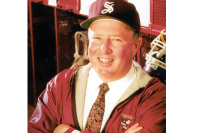All in the design: NOC experts lend ideas on kayaks
When the new line of 2009 kayaks hits the outfitters’ stores in coming weeks, the mark of paddling guru Wayner Dickert will be lurking beneath more than one hull.
The former Olympic paddler has long been a go-to guy for boat manufacturers. In the trenches at Nantahala Outdoor Center’s paddling school where thousands flock every year to improve their skills, Dickert has a foot soldier’s view of the demands in the boat market.
Of all the boats Dickert consulted on this year, he’s most excited about a new boat by Dagger — the Karnali — named for a mega-river in Nepal. As a paddling instructor, Dickert’s constant challenge to boat makers is to design a kayak that strikes a balance between the mutually exclusive traits desirable to a beginner versus an expert. For example, beginners need a boat that’s stable, thus a flatter hull. But more rounder bottoms move better if you have the skills to handle them.
Another set of attributes that are mutually exclusive: a boat that’s stable when upright, yet easy to flip back up if you capsize.
The new Karnali by Dagger attempts to find the perfect balance of all these with the beginner in mind.
“It was literally built because of our instruction programs,” Dickert said. “We wanted a boat that was easy to paddle, easy to roll and still has great stability. They completely went back to the drawing board and built this boat really around a lot of the comments and recommendations that we had.”
The paddling companies often call on NOC staffers for input when crafting new boats.
“It is pretty common that a manufacturer will call or email and say ‘Hey, we are working on this. What do you think it ought to be?’” Dickert said.
Those called on for advice range from the paddling teachers to the outfitters store. And why not?
“We are the frontrunner for instruction in North America and probably put more people through courses than anybody possibly in the world,” said Robert Bone, NOC’s boat buyer.
As the guy who chooses which boats NOC buys, whether it’s for their rental fleet, for the paddling school or to stock in the outfitters store, Bone is another guy boat makers want to curry favor with.
“It’s a pretty common occurrence,” Bone said of NOC staffers consulting on new boat designs. “We’ve been involved in designing boats for 30 years. It is pretty neat to be thought of in the industry as the people they go to. That’s the cool thing about NOC, is we have that expertise and the manufacturers feel comfortable coming to us and asking what’s going to sell on the marketplace.”
Rival boats
The NOC staffers are equal opportunity consultants.
“Because we carry all the lines, we have a neutral perspective,” Dickert said. “We look at boats from the perspective of what will help our guests become the best paddler they can be.”
In other words, someone looking for a boat — whether to rent for the day or to buy — will be pointed toward the one that best suits their ability and interests out of all the available lines, not just the best out of Liquid Logic’s line, or from Jackson Kayaks’ line.
That means Dickert can be consulting for more than company at a time. On ’09 designs, Dickert lent his two cents to both Dagger and Pyranha. Unbeknownst to each other, both were working on similar tracks, although Dickert couldn’t reveal it until the boats were ready.
“They ended up being so similar that when they saw each other’s boats they said ‘Hey, that’s our boat,’” Dickert said. “They are still definitely different boats and each one has its own special micro niche it will fit into, but each others’ jaw dropped.”
It’s not uncommon for boat makers to head down similar paths, just like car makers or electronic makers come out with similar innovations the same year.
“They knew there was a need in the industry and they ended up getting to similar places to fill that need, so that means to me they called it pretty well,” Dickert said of Dagger’s new Axium and Pyranha’s new Zone.
Hands-on
In exchange for his input, Dickert hopes to earn a free boat when the line comes out. But occasionally, he lands a gig on a prototype team that sees a boat through from inception to the final product.
One such boat was the GT, an innovative boat developed by Dagger a few years ago. Dickert laid down the initial challenge — to find the perfect middle ground between the stability of a play boat and the maneuverability of the river running kayaks.
Here’s a crash course for the non-paddler: a play boat sports a shorter, stubbier, fatter snout good for bouncing around on waves, while a river runner is longer and sleeker. Each boat calls for a specific hull type. The river runner has a displacement hull with a rounded bottom for slicing through the water, while the play boat has a planing hull that’s flatter for sitting on top of the water.
“The challenge was finding a good balance to where you still got the benefit of that flat bottom hull,” Dickert said.
After some initial consultations with the designers, they built a few prototypes, and that’s when things got fun. Dickert and a team of three other paddlers hit the water with the prototypes, trading boats over the course of the day to get a feel for each.
“We would sit around and compare notes and say ‘What did you like about this, what did it do well, what did it not do well.’ We would figure out what needed to be changed and they would go back and try to make that happen,” Dickert said.
The team took each new set of prototypes out on the water, refining, refining, refining each time.
“When we got it on the water if it didn’t work out like we thought it would we’d say ‘Let’s change this,’” Dickert recounted. They went through upwards of 15 prototypes this way before Dagger cut them off.
“You try to keep getting it closer and closer, but it’s one of those things where at some point you have to draw a line,” Dickert said. “It is all a compromise.”
Dickert’s hard work was vindicated when the GT got Boat of the Year by Outside magazine that year.
Paddling industry pins hope on new designs to stoke interest
The new lines of kayaks and canoes this year have one mission in common: to lure new converts.
“Most of the manufacturers are coming out with boats that are more beginner and intermediate friendly. This is a push to get more people involved in paddling as new boaters have been declining for the past decade,” said Robert Bone, a boat expert at Nantahala Outdoor Center. “They realize we have to grow this market segment. To keep it viable for the manufacturers, they have to get new people involved, thus the new designs.”
There’s been a decline in paddling for the past eight years, Bone said. Thousands flock to NOC’s courses each year to learn how to paddle. But if newcomers can’t get the hang of it, at least enough see a light at the end of the tunnel, they give up.
“The learning curve is very steep in the first several years,” Bone said.
While it’s more fun for boat makers, who are often world-class paddlers themselves, to design high-power, high performance boats tailored to other experts like them, the NOC crew has help pushed designers into considering the beginners.
“For the beginning paddler you need something that gives them a lot of confidence on the river. They need to get on the river and feel like they can really do it and then they’ll come back and turn it into a life time sport, so that’s what I wanted to do more than anything,” said Wayner Dickert, a world-class paddler and instructor at NOC.
There’s a trade-off when designing a boat — a kayak with high maneuverability for experienced paddlers versus one more likely to stay upright. NOC staffers kept asking the manufacturers for a more forgiving boat, and they finally responded.
“It is nice to have the manufacturers listen to you and develop a boat for your specific market,” Bone said. “We really appreciate that.”
The boat companies are also pitching boats this year that can multi-task. The expert paddler has an arsenal of boats to fill every niche of water imaginable, whether it’s the best boat for making fast tracks on a lake or barreling over class V waterfalls on narrow creeks. Play boats are even tailored toward the type of trick they perform best for, with some handling best for enders and cartwheels and the others for stern squirts and spins.
Dickert has eight boats from that came out in 2008 alone, and doesn’t consider it a lot.
“I am actually pretty lean on boats right now,” Dickert said.
But those just entering the sport haven’t built up their stockpile of boats yet.
They need cross-over boats that aren’t so tailored to just one kind of paddling.
“They’re manufacturing boats to fit a wider range, that caters to that beginner boater who wants to do some of both,” Bone said.
A unique twist on luring more people into paddling is a new two-person kayak by Jackson Kayak. The tandem kayak is the first of its kind in more than a decade and will hopefully help get people hooked.
“You will have somebody experienced in the back of the boat and some one who has never kayaked in their life taking them down river and hopefully get them excited and hopefully get them to buy a boat,” Bone said. “It is all about trying to increase the participation in whitewater paddling.”
There’s another trend Bone sees in boats this year.
“It seems like everybody has kind of gone back to retro designs, little longer designs for river running and stability,” Bone said. “The steam has been dropping from the play boat scene for a while now. That has taken a bit of a backseat to plain old river running in the last couple years.”
Final countdown to the Chattooga decision
There are nine scenarios on the table in the debate over whether paddling should be allowed on the Upper Chattooga. They run the gamut, from a paddling free-for-all to none at all. The scenarios in between limit paddling under various conditions. The forest service most likely will chose one these “compromise” scenarios:
The Chattooga compromise: With solitude at stake, Chattooga recreation to be reined in
A long-awaited decision over paddling on the Upper Chattooga is expected within weeks by the National Forest Service.
A life in the rapids
By Jennifer Garlesky •Staff Writer
The raging Class II rapids of the Cacapon River, which flows along the eastern panhandle of West Virginia, hooked Doug Woodward on whitewater paddling.





